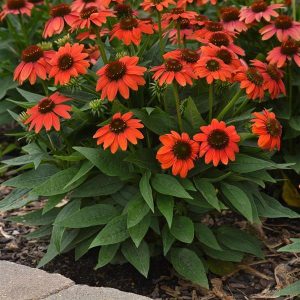
Echinacea Sombrero – Poco Hot Coral
Echinacea Sombrero ‘Poco Hot Coral’ Coneflower is a garden superstar with its compact, well branched habit and prolific blooms. The large, single, daisy like flowers are coral hued surrounding the rusty brown cone. This petite perennial is a splendid choice for borders and does equally well in the container garden.
Attractive to butterflies, Echinacea Sombrero ‘Poco Hot Coral’ Coneflower is also a magnet for important pollinators and beneficial insects. The flower heads provide visual winter interest and are an important food source for birds.
The Sombrero series is a new introduction bred to produce well-branched, sturdy and compact plants featuring a high bud count.
U.S. Plant Patent #26,639.

Echinacea Sombrero ‘Baja Burgundy’ Coneflower
Echinacea Sombrero ‘Baja Burgundy’ is characterized by intense burgundy blooms atop strong, well-branched stems. The large, single, daisy like flowers are bright red surrounding a large brown cone. The showy flowers bloom happily from mid-summer to frost and are easy to grow plants tolerant of drought, heat, humidity and poor soil.
Attractive to butterflies, Echinacea Sombrero ‘Baja Burgundy’ Coneflower is also a magnet for important pollinators and beneficial insects. The flower heads provide visual winter interest and are an important food source for birds.
The Sombrero series is a new introduction bred to produce well-branched, sturdy and compact plants featuring a high bud count.
Grown in 4.5″ square pots.
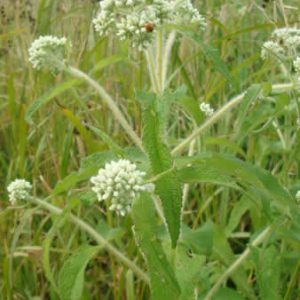
Eupatorium perfoliatum – Boneset
Growing in moist conditions, Eupatorium perfoliatum (Boneset) produces flat to roundish heads of white flowers. The stem is covered with long spreading hairs with leaves that are often joined at the base, appearing to surround the stem. Many different insect species are attracted to the flowers as the nectar is relatively easy to access.
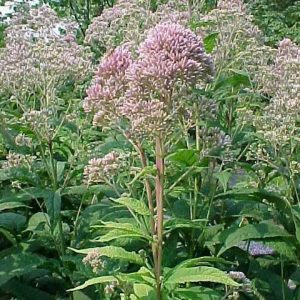
Eutrochium purpureum – Purple Joe Pye Weed
Easily grown in average, medium moisture soils in full sun to part shade. Prefers moist, fertile, humusy soils which do not dry out. Cut plants to the ground in late winter. Best propagated by stem cuttings. This species generally grows … Read More

Gaillardia grandiflora – Arizona Apricot
‘Arizona Apricot’ has yellow flowers with a deep apricot-orange center and is an AHS winner.
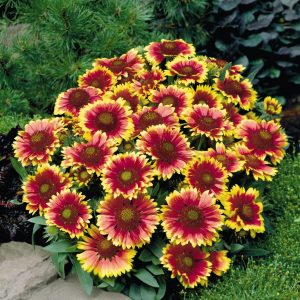
Gaillardia grandiflora – Arizona Sun Blanket Flower
2005 All-America Selections Winner 10″ tall x 12″ wide. 'Arizona Sun' is one of our finest Gaillardia cultivars with showy three-inch single flowers that are mahogany-red with bright yellow edges. It has better uniformity and more numerous flowers than older varieties and is a remarkable garden performer. Plant in well-drained infertile soils for best results. Deadhead occasionally to keep the flowers coming all summer long
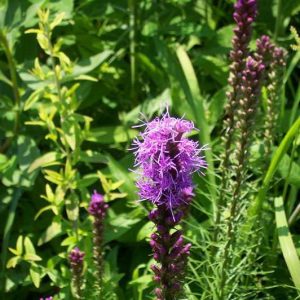
Liatris spicata – Dense Blazingstar
Easily grown in average, medium, well-drained soils in full sun. Somewhat tolerant of poor soils, but prefers moist, fertile ones and generally performs better in moist soils than most other species of Liatris. Intolerant of wet soils in winter. Tolerant of summer heat and humidity. May be grown from seed, but is slow to establish.
Noteworthy Characteristics
Blazing star (also commonly called dense blazing star or marsh blazing star) is a tall, upright, clump-forming perennial which is native to moist low grounds, meadows and marsh margins. In Missouri, it has only been found in Oregon County on the Arkansas border (Steyermark). It typically grows 2-4′ tall in cultivation, but can reach a height of 6′ in some parts of its native habitat. Features terminal spikes (6-12″ long) of sessile, rounded, fluffy, deep purple flower heads (each to 3/4″ across) appearing atop rigid, erect, leafy flower stalks. One or more stalks arise from a basal tuft of narrow, grass-like, medium green leaves (to 12″ long). Stem leaves gradually decrease in size toward the top. Blooms in summer. Liatris belongs to the aster family, with each flower head having only fluffy disk flowers (resembling “blazing stars”) and no ray flowers. The feathery flower heads of liatris give rise to another common name of gayfeather. See also L. spicata‘Kobold’ which is a popular compact cultivar that is less likely to need staking than the species.
Available May – Mid May 2017

Lindera benzoin – Spicebush
Spicebush is a deciduous shrub with a broad, rounded habit which typically grows 6-12′ (less frequently to 15′) high in moist locations in bottomlands, woods, ravines, valleys and along streams. Clusters of tiny, apetulous, aromatic, greenish-yellow flowers bloom along the branches in early spring before the foliage emerges. Dioecious (male and female flowers on separate plants), with the male flowers being larger and showier than the female ones. Flowers of female plants give way to bright red drupes (to 1/2″ long) which mature in fall and are attractive to birds. Female plants need a male pollinator in order to set fruit, however. Drupes are very attractive, but are largely hidden by the foliage until the leaves drop. Thick, oblong-obovate, light green leaves (to 5″ long) turn an attractive yellow in autumn. Leaves are aromatic when crushed. The larva (caterpillar) of the spicebush swallowtail butterfly feeds on the leaves of this shrub.Lindera is named for the Swedish botanist, Johann Lindler.
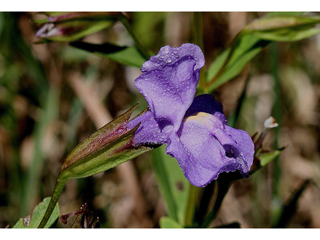
Mimulus ringens – Monkeyflower
This perennial plant is 1-3′ tall, branching occasionally to frequently. The light green stems are glabrous and bluntly 4-angled, but they are not conspicuously winged. The opposite leaves are up to 4″ long and 1″ across; they are light to medium green, lanceolate or elliptic-oblanceolate in shape, glabrous, and serrated to sparingly serrated along their margins. The leaves are sessile or they clasp the stems; petioles are absent. Leaf bases are round to slightly cordate, while their tips are slender and pointed. Individual flowers develop from the leaf axils of the middle to upper stems. These flowers are about 1″ long, and they have two-lipped corollas that are usually pale blue-violet (less often pink or white).
Available May – Mid May 2015

Ruellia humilis – Wild Petunia
Host plant – Common Buckeye Butterfly
Wild petunia occurs in dryish soils in open woods, glades, prairies and fields throughout the State except for the far southeastern lowlands. Typically grows to 2′ tall. Features tubular, bell-shaped, petunia-like flowers (to 3″ long), each with five shallow rounded lobes. May to October bloom period. Lavender to lilac flowers appear singly or in clusters in the upper leaf axils. Oblong to lanceolate, olive green leaves to 4″ long. Leaves and stems are hairy. This plant in on threatened list in the state of Michigan.
Available for shipping mid May
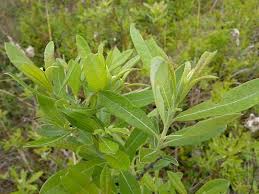
Salix humilis – Prairie Willow
This shrub is 2-8′ tall, often branching near the base and toward the tips of older stems. Woody stems are terete and variably colored – usually some shade of yellowish tan, brown, or gray. Young woody stems are often short-pubescent, but they become glabrous with age. New shoots are light green and short-pubescent. Alternate leaves occur along young stems and shoots. The leaf blades are 1¾-4″ long and ¼-¾” across; they are narrowly lanceolate, oblanceolate, or oblong-elliptic in shape and smooth to slightly crenate along their margins. The margins are often revolute (curved downward) as well. The upper surface of the leaf blades is medium green or grayish green and glabrous to sparsely short-pubescent, while the lower surface (for this variety of Prairie Willow) is short-pubescent and sometimes whitened. The petioles are ¼-½” in length and short-pubescent. At the base of the petioles, lanceolate stipules are sometimes found.
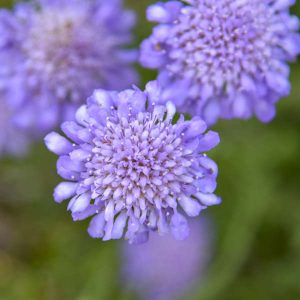
Scabiosa columbaria ‘Butterfly Blue’ – Pincushion Flower
Common Name: Pincushion Flower This selection produces a profusion of lavender-blue, pincushion-like flowers over a very long period beginning in late spring. They sit atop wiry stems which hover over the short mound of ferny basal foliage. They make … Read More
